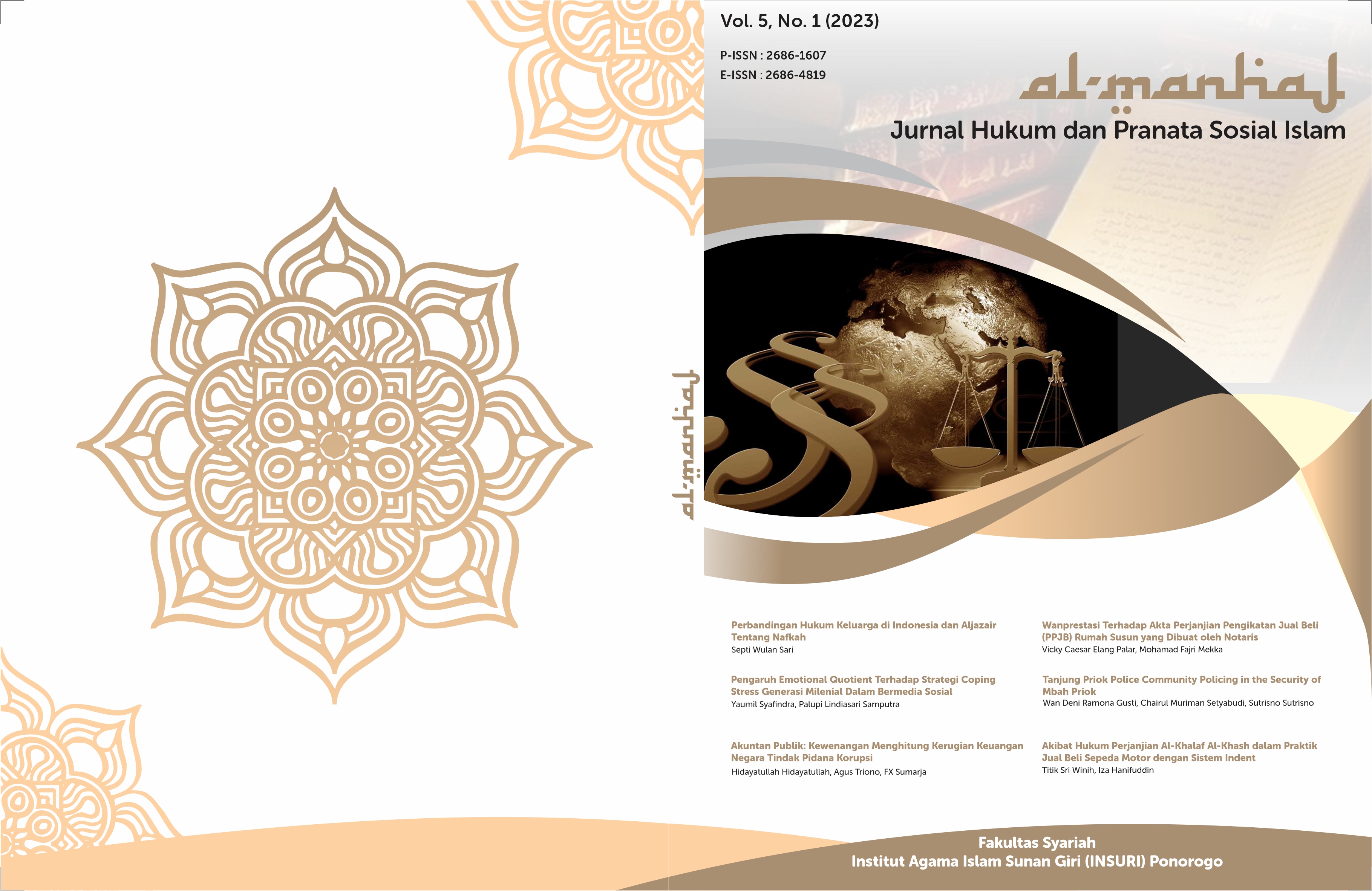Criminological Review of the Influence of Kameko Drink on Juvenile Perpetrators of Assault Crimes
DOI:
https://doi.org/10.37680/almanhaj.v5i1.2713Keywords:
Criminology; Kameko; Assault CrimeAbstract
The aim of this research is to determine the factors influencing children's consumption of Kameko drink in the legal jurisdiction of Kulisusu sector and to determine the efforts of the Kulisusu sector police in preventing the circulation of Kameko drink among children. The approach method used in this study are using several approaches as whole unities, which are statute approach, case approach, and conceptual approach The research was conducted in the Kulisusu sector police area. The data sources consist of primary data supported by secondary data. Data collection techniques used were interviews and observations. The analysis technique used is qualitative descriptive method. The results of this research show that the factors influencing children's consumption of Kameko drink in the legal jurisdiction of Kulisusu sector can be grouped into determining factors and supporting factors. consuming alcohol makes children unable to focus on school, disrupt their studies, experience memory or memory problems, and increase the risk of suicide. Efforts made to combat the circulation of Kameko drink in the legal jurisdiction of Kulisusu sector include preventive and repressive measures.
References
Cunneen, C. (2023). A Brief History Of Policing. In Defund The Police (Pp. 21–41). Policy Press.
Erich, E., Maryano, M., & Martanti, Y. (2023). Perlindungan Hukum Terhadap Itikad Baik Penerima Kuasa Yang Bertindak Di Luar Kuasa Yang Dibuat Secara Autentik. Jurnal Hukum Indonesia, 2(1), 42–52.
Febriyana, M. (2023). The Influence Of Gadget Playing On Adolescent Behavior In Families In Pematang Kuala Village. Proceeding International Seminar Of Islamic Studies, 1691–1703.
Ismail, R. R. (2023). Analisis Kekerasan Terhadap Anak Ditinjau Dari Prespektif Kriminologi Kejahatan. Syntax Literate; Jurnal Ilmiah Indonesia, 8(3), 2051–2060.
Kamaru, M. F. O. D. E. (2017). Tinjauan Kriminglogis Perkelahian Antar Kelompok Remaja Dl Kabupaten Muna.
Karlina, L. (2020). Fenomena Terjadinya Kenakalan Remaja. Jurnal Edukasi Nonformal, 1(1), 147–158.
Marbun, S. M., Th, S., & Pdk, M. (2018). Psikologi Pendidikan. Uwais Inspirasi Indonesia.
Nasution, H. A. (2020). Patologi Sosial Dan Pendidikan Islam Keluarga. Scopindo Media Pustaka.
Ningsih, T. W. (2019). Penyalahgunaan Minuman Beralkohol Dalam Lingkup Remaja.
Prasasti, S. (2017). Kenakalan Remaja Dan Faktor Penyebabnya. Prosiding Seminar Nasional Bimbingan Dan Konseling, 1(1), 28–45.
Ridwan, I. H. J., & Sudrajat, M. H. A. S. (2020). Hukum Administrasi Negara Dan Kebijakan Pelayanan Publik. Nuansa Cendekia.
Salam, A. (2018). Politik Dan Budaya Kejahatan. Ugm Press.
Setyawan, S. A., Gustaf, M. A. M., Pambudi, E. D., Fatkhurrozi, M., & Anwar, S. (2019). Pergaulan Bebas Di Kalangan Mahasiswa Dalam Tinjauan Kriminologi Dan Hukum. Seminar Nasional Hukum Universitas Negeri Semarang, 163–186.
Shofiyannajah, S., & Nurcahyo, M. S. (2023). Impelementasi Kode Etik Jurnalistik Dalam Peliputan Berita Kriminal Wartawan Jatimnow. Com. Digicom: Jurnal Komunikasi Dan Media, 3(1), 16–23.
Siahaan, A. N., Ikhsan, R., & Nashriana, N. (2018). Tinjauan Kriminologi Terhadap Pengaruh Minuman Keras Bagi Anak Pelaku Tindak Pidana Penganiayaan. Sriwijaya University.
Simatupang, N. (2017). Kriminologi: Suatu Pengantar. Pustaka Prima.
Unayah, N., & Sabarisman, M. (2015). Fenomena Kenakalan Remaja Dan Kriminalitas. Sosio Informa: Kajian Permasalahan Sosial Dan Usaha Kesejahteraan Sosial, 1(2).
Wirasyafri, W., & Rinaldi, K. (2023). Pemberian Sanksi Terhadap Pelaku Balap Liar (Studi Kasus Balap Liar Di Jalan Arifin Ahmad Kota Pekanbaru). Seikat: Jurnal Ilmu Sosial, Politik Dan Hukum, 2(2), 101–106.
Downloads
Published
How to Cite
Issue
Section
License
Copyright:
- Author retains the copyright and grants the journal the right of first publication of the work simultaneously licensed under a Creative Commons Attribution 4.0 International License that allows others to share the work with an acknowledgment of the work's authorship and initial publication in this journal.
- Author is able to enter into separate, additional contractual arrangements for the non-exclusive distribution of the journal's published version of the work (e.g., post it to an institutional repository or publish it in a book) with the acknowledgment of its initial publication in this journal.
- Author is permitted and encouraged to post his/her work online (e.g., in institutional repositories or on their website) prior to and during the submission process, as it can lead to productive exchanges, as well as earlier and greater citation of the published work (See The Effect of Open Access).
License:
-
Attribution — You must give appropriate credit, provide a link to the license, and indicate if changes were made. You may do so in any reasonable manner, but not in any way that suggests the licensor endorses you or your use.
-
No additional restrictions — You may not apply legal terms or technological measures that legally restrict others from doing anything the license permits.
You are free to:
- Share — copy and redistribute the material in any medium or format
- Adapt — remix, transform, and build upon the material for any purpose, even commercially.

This work is licensed under a Creative Commons Attribution 4.0 International License.














